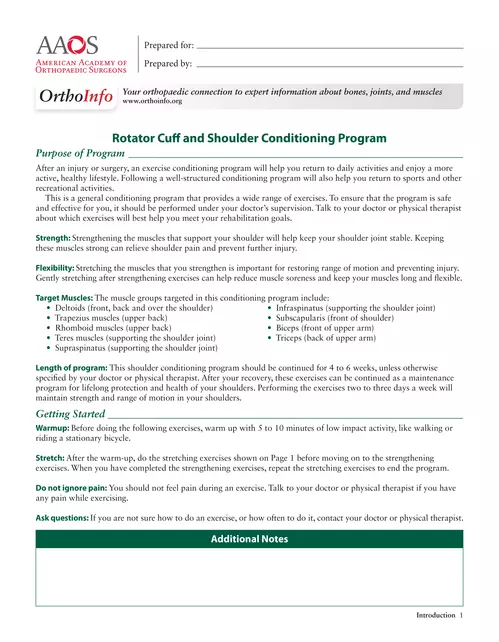
Rotator Cuff and Shoulder Conditioning Program
The following exercises should be done 3 to. 5 times a day to strengthen your Deltoid muscle. The aim is to reduce your pain and improve both the range of
adsPart of the document
After an injury or surgery, an exercise conditioning program will help you return to daily activiti
es and enjoy a more
active, healthy lifestyle. Following a well-structured conditioning program will also help you ret
urn to sports and other
recreational activities.
This is a general conditioning program that provides a wide range of exe
rcises. To ensure that the program is safe
and effective for you, it should be performed under your doctor's supervision. Talk to your doctor or physical therapist
about which exercises will best help you meet your rehabilitation goals.
Strength:
Strengthening the muscles that support your shoulder will help keep your
shoulder joint stable. Keeping
these muscles strong can relieve shoulder pain and prevent further injur
y.
Flexibility: Stretching the muscles that you strengthen is important for restoring ra
nge of motion and preventing injury.
Gently stretching after strengthening exercises can help reduce muscle s
oreness and keep your muscles long and exible.
Target Muscles:
The muscle groups targeted in this conditioning program include:
Deltoids (front, back and over the shoulder)
Trapezius muscles (upper back)
Rhomboid muscles (upper back)
Teres muscles (supporting the shoulder joint)
Supraspinatus (supporting the shoulder joint) Infraspinatus (supporting the shoulder joint) Subscapularis (front of shoulder) Biceps (front of upper arm) Triceps (back of upper arm)
Length of program:
This shoulder conditioning program should be continued for 4 to 6 weeks,
unless otherwise
speci ed by your doctor or physical therapist. After your recovery, these exercises can be continued as a maintenance
program for lifelong protection and health of your shoulders. Performing the exercises two to three days a week will
maintain strength and range of motion in your shoulders.
Getting Started
Warmup:
Before doing the following exercises, warm up with 5 to 10 minutes of low impact activity, like walking or
riding a stationary bicycle.
Stretch:
After the warm-up, do the stretching exercises shown on Page 1 before moving on to the str
engthening
exercises. When you have completed the strengthening exercises, repeat the stretching exercises to end the program.
Do not ignore pain:
You should not feel pain during an exercise. Talk to your doctor or physical therapist if you have
any pain while exercising.
Ask questions:
If you are not sure how to do an exercise, or how often to do it, contact your doctor or physical therapist.
© American Academy of Orthopaedic Surgeons Exercises Page 1
Rotator Cu? and Shoulder Conditioning Program


